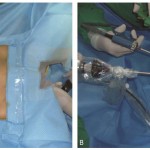Robotic Total Pelvic Exenteration
Shailesh P Puntambekar, NallapothulaKathya, ChaitanyaMallireddy, Seema S Puntambekar, GeetanjaliAgarwal, Saurabh Joshi, Rahul Kenawadekar, AkhilLawande.
ABSTRACT
Introduction
Pelvic exenteration is now becoming widely acceptable as a curative procedure rather than a palliative one. Performing these surgeries by minimally invasive techniques helps to improve the quality of life and decrease the morbidity of these extensive procedures.
Aims and objectives
To demonstrate the feasibility of performing a total pelvic exenteration robotically, and to study the morbidity associated with such extensive surgery.
Materials and methods
A 35-year-old female with advanced cervical cancer presented with a vesicovaginal fistula and a rectovaginal fistula. In view of these, we performed a total robotic pelvic exenteration with colo-anal anastomosis and uretero-sigmoidostomy. The patient refused an ileal-loop conduit for urinary tract diversion due to social reasons associated with a stoma.
Results
The total operative time was 240 min and the console time was 120 min. The estimated blood loss was 300 ml and the intensive care unit stay was 2 days. Post-operatively, the patient had good faecal and urinary continence and good quality of life.

